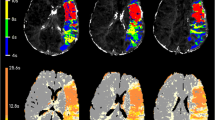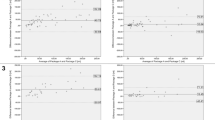Abstract
The purpose of our study was to identify the perfusion MRI (pMRI) algorithm which yields a volume of hypoperfused tissue that best correlates with the acute clinical deficit as quantified by the NIH Stroke Scale (NIHSS) and therefore reflects critically hypoperfused tissue. A group of 20 patients with a first acute stroke and stroke MRI within 24 h of symptom onset were retrospectively analyzed. Perfusion maps were derived using four different algorithms to estimate relative mean transit time (rMTT): (1) cerebral blood flow (CBF) arterial input function (AIF)/singular voxel decomposition (SVD); (2) area peak; (3) time to peak (TTP); and (4) first moment method. Lesion volumes based on five different MTT thresholds relative to contralateral brain were compared with each other and correlated with NIHSS score. The first moment method had the highest correlation with NIHSS (r=0.79, P<0.001) followed by the AIF/SVD method, both of which did not differ significantly from each other with regard to lesion volumes. TTP and area peak derived both volumes, which correlated poorly or only moderately with NIHSS scores. Data from our pilot study suggest that the first moment and the AIF/SVD method have advantages over the other algorithms in identifying the pMRI lesion volume that best reflects clinical severity. At present there seems to be no need for extensive postprocessing and arbitrarily defined delay thresholds in pMRI as the simple qualitative approach with a first moment algorithm is equally accurate. Larger sample sizes which allow comparison between imaging and clinical outcomes are needed to refine the choice of best perfusion parameter in pMRI.




Similar content being viewed by others
References
Schellinger PD, Fiebach JB, Hacke W (2003) Imaging-based decision making in thrombolytic therapy for ischemic stroke: present status. Stroke 34(2):575–583
Warach S, Dashe JF, Edelman RR (1996) Clinical outcome in ischemic stroke predicted by early diffusion-weighted and perfusion magnetic resonance imaging: a preliminary analysis. J Cereb Blood Flow Metab 16(1):53–59
Beaulieu C, de Crespigny A, Tong DC, et al (1999) Longitudinal magnetic resonance imaging study of perfusion and diffusion in stroke: evolution of lesion volume and correlation with clinical outcome. Ann Neurol 46(4):568–578
Schellinger PD, Fiebach JB, Jansen O, et al (2001) Stroke magnetic resonance imaging within 6 hours after onset of hyperacute cerebral ischemia. Ann Neurol 49(4):460–469
Warach S, Pettigrew LC, Dashe JF, et al (2000) Effect of citicoline on ischemic lesions as measured by diffusion-weighted magnetic resonance imaging. Citicoline 010 Investigators. Ann Neurol 48(5):713–722
Röther J, Schellinger PD, Gass A, et al (2002) Effect of intravenous thrombolysis on MRI parameters and functional outcome in acute stroke <6 h. Stroke 33(10):2438–2445
Kidwell CS, Saver JL, Mattiello J, et al (2000) Thrombolytic reversal of acute human cerebral ischemic injury shown by diffusion/perfusion magnetic resonance imaging. Ann Neurol 47(4):462–469
Fiehler J, Foth M, Kucinski T, et al (2002) Severe ADC decreases do not predict irreversible tissue damage in humans. Stroke 33(1):79–86
Warach S (2001) Tissue viability thresholds in acute stroke: the 4-factor model. Stroke 32(11):2460–2461
Grandin CB, Duprez TP, Smith AM, et al (2002) Which MR-derived perfusion parameters are the best predictors of infarct growth in hyperacute stroke? Comparative study between relative and quantitative measurements. Radiology 223(2):361–370
Yamada K, Wu O, Gonzalez RG, et al (2002) Magnetic resonance perfusion-weighted imaging of acute cerebral infarction: effect of the calculation methods and underlying vasculopathy. Stroke 33(1):87–94
Neumann-Haefelin T, Wittsack HJ, Wenserski F, et al (1999) Diffusion and perfusion weighted MRI. The DWI/PWI mismatch region in acute stroke. Stroke 30:1591–1597
Butcher K, Parsons M, Baird T, et al (2003) Perfusion thresholds in acute stroke thrombolysis. Stroke 34(9):2159–2164
Rosen BR, Belliveau JW, Vevea JM, Brady TJ (1990) Perfusion imaging with NMR contrast agents. Magn Reson Med 14:249–265
Schlaug G, Benfield A, Baird AE, et al (1999) The ischemic penumbra: operationally defined by diffusion and perfusion MRI. Neurology 53(7):1528–1537
Ostergaard L, Weisskoff RM, Chesler DA, Gyldensted C, Rosen BR (1996) High resolution measurement of cerebral blood flow using intravascular tracer bolus passages, part I: mathematical approach and statistical analysis. Magn Reson Med 36:715–725
Heiland S, Benner T, Reith W, Forsting M, Sartor K (1997) Perfusion-weighted MRI using gadobutrol as a contrast agent in a rat stroke model. J Magn Reson Imaging 7(6):1109–1115
Kidwell CS, Alger JR, Saver JL (2003) Beyond mismatch: evolving paradigms in imaging the ischemic penumbra with multimodal magnetic resonance imaging. Stroke 34(11):2729–2735
Wu O, Ostergaard L, Koroshetz WJ, et al (2003) Effects of tracer arrival time on flow estimates in MR perfusion-weighted imaging. Magn Reson Med 50(4):856–864
Calamante F, Gadian DG, Connelly A (2002) Quantification of perfusion using bolus tracking magnetic resonance imaging in stroke: assumptions, limitations, and potential implications for clinical use. Stroke 33(4):1146–1151
Sorensen AG (2001) What is the meaning of quantitative CBF? AJNR Am J Neuroradiol 22:235–236
Warach S (2003) Measurement of the ischemic penumbra with MRI: it's about time. Stroke 34(10):2533–2534
Lyden P, Brott T, Tilley B, et al (1994) Improved reliability of the NIH Stroke Scale using video training. NINDS TPA Stroke Study Group. Stroke 25(11):2220–2226
Neumann-Haefelin T, Wittsack HJ, Fink GR, et al (2000) Diffusion- and perfusion-weighted MRI—influence of severe carotid artery stenosis on the DWI/PWI mismatch in acute stroke. Stroke 31(6):1311–1317
Hillis AE, Wityk RJ, Barker PB, Ulatowski JA, Jacobs MA (2003) Change in perfusion in acute nondominant hemisphere stroke may be better estimated by tests of hemispatial neglect than by the National Institutes of Health Stroke Scale. Stroke 34(10):2392–2396
Schellinger PD, Jansen O, Fiebach JB, et al (2000) Feasibility and practicality of MR imaging of stroke in the management of hyperacute cerebral ischemia. AJNR Am J Neuroradiol 21(7):1184–1189
Berrouschot J, Barthel H, Hesse S, et al (2000) Reperfusion and metabolic recovery of brain tissue and clinical outcome after ischemic stroke and thrombolytic therapy. Stroke 31(7):1545–1551
Warach S (2004) Early reperfusion related to clinical response in DIAS—Phase II, randomized, placebo-controlled dose finding trial of IV desmoteplase 3–9 hours from onset in patients with diffusion–perfusion mismatch. ASA International Stroke Conference, San Diego, CA
Dunn B, Davis L, Todd J, Chalela J, Warach S (2004) Safety of combined abciximab and reteplase in acute ischemic stroke: interim results of ReoPro Retavase Reperfusion of Stroke Safety Study Imaging Evaluation (ROSIE). Annual Meeting of the American Academy of Neurology, San Francisco, CA
Stroke (2003) Major ongoing stroke trials. Stroke 34(6):e61–e72
Acknowledgements
Jeff Solomon, PhD, of Sensor Systems, Inc. provided invaluable technical support for MedX operations and wrote the macro program that allowed volume analysis by varying degrees of rMTT delay. Drs. Gregory Samsa and Larry Goldstein of Duke Medical School helped refine the interpretation of results by suggesting some of the statistical tests used in this study. This work was in part performed for a research thesis required for graduation from Duke Medical School (Chen-Sen Wu). Patient data were collected with the assistance of members of the Division of Cerebrovascular Diseases at Beth Israel-Deaconess Medical Center in Boston, Massachusetts, USA, during the years 1997–1999. There are no conflicts of interest.
Author information
Authors and Affiliations
Corresponding author
Rights and permissions
About this article
Cite this article
Schellinger, P.D., Latour, L.L., Wu, CS. et al. The association between neurological deficit in acute ischemic stroke and mean transit time. Neuroradiology 48, 69–77 (2006). https://doi.org/10.1007/s00234-005-0012-9
Received:
Accepted:
Published:
Issue Date:
DOI: https://doi.org/10.1007/s00234-005-0012-9




